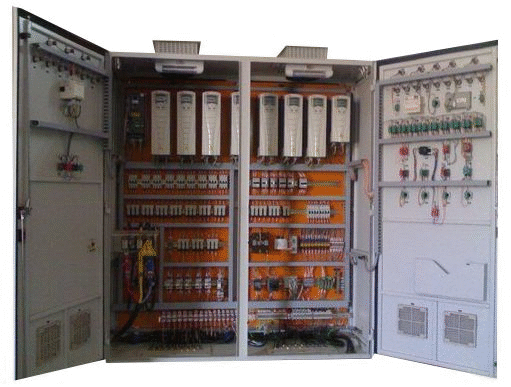AC DRIVE / VFD CONTROL PANEL
IMPORTANCE OF VFD PANEL – UNDERSTADING VFD CONTROL PANEL
VFD (Variable Frequency Drive) panels are important for several reasons:
Centralized Control: VFD panels provide centralized control of multiple VFDs, allowing operators to monitor and control the speed and torque of multiple motors from a single location. This can help improve efficiency and reduce downtime by allowing operators to quickly respond to changes in load or process conditions.
Safety: VFD panels are designed with safety features that help protect personnel and equipment from electrical hazards, such as overcurrent protection, short circuit protection, and ground fault protection. These features help ensure that the VFDs and connected equipment operate safely and reliably.
Monitoring and Diagnostics: VFD panels can provide real-time monitoring and diagnostics of the VFDs and connected equipment, allowing operators to detect and address issues before they become serious problems. This can help reduce downtime, improve efficiency, and extend the life of the VFDs and connected equipment.
Space Savings: VFD panels are designed to house multiple VFDs in a single enclosure, which can help save space and reduce the amount of wiring and cabling required to connect the VFDs to the motors and other equipment.
Customization: VFD panels can be customized to meet the specific needs of the application, including the number of VFDs, the size of the enclosure, and the type of control interface.
Overall, VFD panels provide a convenient, safe, and efficient way to control and monitor multiple VFDs from a single location, which can help improve productivity, reduce downtime, and extend the life of the VFDs and connected equipment.
COMPONENTS OF AC DRIVE PANEL
An AC drive panel, also known as a variable frequency drive (VFD) panel, typically consists of the
following components:
1. VFD: This is the main component of the AC drive panel, which controls the speed and torque of
the AC motor. It receives signals from the control system and adjusts the frequency and voltage
of the electrical supply to the motor accordingly.
2. Power Section: The power section of the AC drive panel consists of various components such as
input filters, rectifiers, and DC bus capacitors. These components are responsible for converting
the incoming AC power into DC power and filtering out any electrical noise or harmonics.
3. Control Board: The control board is responsible for processing signals from the control system
and providing instructions to the VFD. It also contains various safety features and diagnostic
tools for monitoring the performance of the AC drive panel.
4. Operator Interface: The operator interface provides a means for the operator to monitor and
control the AC drive panel. This may include a touch screen display, push buttons, or other types
of control devices.
5. Protection Devices: Protection devices such as circuit breakers, fuses, and surge suppressors are
included in the AC drive panel to protect against overcurrent, overvoltage, and other electrical
faults that may occur.
6. Cooling System: The cooling system is used to dissipate heat generated by the VFD and other
components. This may include fans, heat sinks, or other cooling devices.
Overall, the components of an AC drive panel work together to control the speed and torque of the AC motor while protecting against electrical faults and ensuring safe and reliable operation.
FAQ's (Frequently Asked Question About VFD Panel)
Q: What is a VFD panel?
A VFD panel is an electrical panel that contains a variable frequency drive (VFD) and other components
that control the speed and torque of an AC motor.
Q. What is the purpose of a VFD panel?
The purpose of a VFD panel is to provide precise and efficient control of an AC motor by varying the
frequency and voltage of the electrical supply to the motor.
Q. What are the benefits of using a VFD panel?
The benefits of using a VFD panel include improved energy efficiency, better process control, reduced
wear and tear on equipment, increased safety, and longer equipment lifespan.
Q. What types of applications are suitable for VFD panels?
VFD panels are suitable for a wide range of applications that require precise and efficient control of AC
motors, including pumps, fans, compressors, conveyors, and other types of machinery.
Q. How do you select the right VFD panel for your application?
Selecting the right VFD panel requires consideration of various factors such as the motor size and type,
the application requirements, the available power supply, and the environmental conditions. It is
recommended to consult with a qualified engineer or VFD supplier to select the appropriate VFD panel
for your specific application.
Q. How do you install and commission a VFD panel?
Installation and commissioning of a VFD panel should be performed by a qualified electrician or
technician who is familiar with the wiring, programming, and testing procedures. It is important to
follow the manufacturer's instructions and safety guidelines to ensure proper installation and operation
of the VFD panel.
Q. How do you maintain and troubleshoot a VFD panel?
Regular maintenance and inspection of a VFD panel can help to prevent issues and ensure reliable
operation. Troubleshooting procedures may include checking for faults or errors in the VFD, control
system, or motor, and performing diagnostic tests or repairs as needed. It is recommended to consult
with a qualified technician or VFD supplier for maintenance and troubleshooting guidance.

FEATURES :
- Dust & Vermin Proof
- Cooling Fan/A.C. Attachment
- Spacious for Maintenance Free
- Wiring Diagram Fixing at Panel Door
- Proper Space for Cable Termination
- Easy for Ready to Use
- AC Drives from 0.25 HP to 300 HP
- Speed/Amp./Rpm Display At Panel
- High torque/Smooth Variation of Speed
